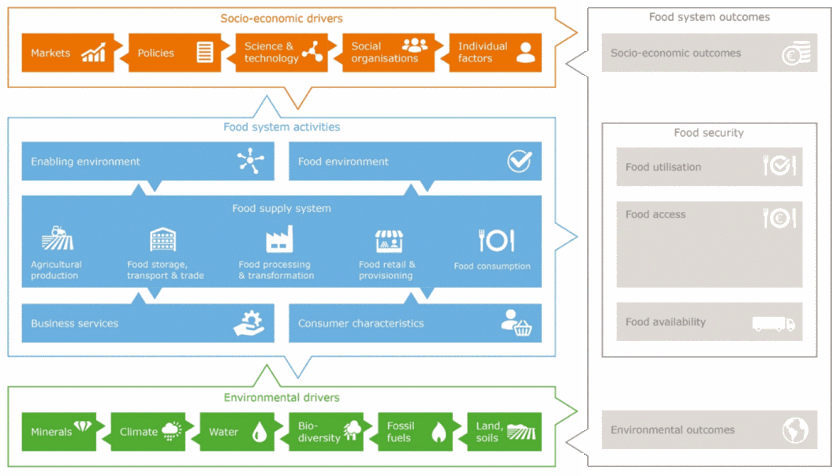
Concepts (Nature-based Solutions for Climate Resilient and Circular Food Systems)
Climate change in combination with population growth and economic developments put the world’s food systems and water resources at high risk. New pathways must be found to ensure that all people have access to sufficient and nutritious food all year round, and to ensure the availability of sufficient water resources are available and ecological values are maintained. There is a growing recognition for the need to change our current linear ways of producing food and feeds into circular systems by closing water, nutrient and carbon cycles and consequently minimize resource loss and mitigate climate change impacts.
At the same time, there is increasing awareness that nature can be a source of inspiration in providing viable solutions to reduce the impact of anticipated negative effects of climate change. These so-called nature-based solutions use and deploy the properties of natural ecosystems and the services that they provide in a smart and in some cases an engineered way. Different or diffuse definitions of the concept of circularity & nature-based solutions exist, often originating from scientific fields outside the agricultural and food domain. At the start of the project, we use the following ‘working definitions’ for the concepts ‘nature–based’ and ‘circularity’.
Nature-based solutions are the focus of the project. For defining nature-based solutions we largely follow the definition from the EU Research and Innovation policy agenda:
"...solutions that are inspired and supported by nature, which are cost-effective, simultaneously provide environmental, social and economic benefits and help build resilience. Such solutions bring more and more diverse, nature and natural features and processes into cities, landscapes and seascapes, through locally adapted, resource-efficient and systemic interventions".
Nature-based solutions use or are inspired by natural resources and ecosystem dynamics for tackling socio-environmental challenges such as climate change, food security or energy transitions. Natural climate solutions can help address climate change in different ways including reducing GHG emissions, such as CO2, CH4 and N2O, related to land use, changes in land use and animal feed, capturing CO2 from the atmosphere and storing carbon in soils. In Nature-based solutions there are gradations possible in the use of natural processes. Some solutions for climate change in food systems can be qualified as intrinsic nature-based solutions (e.g. use of existing wetlands for water purification), while others are merely inspired by natural processes. In the first case ecosystem dynamics are acknowledged and used in making food systems more sustainable and climate resilient without changing the dynamics, while in case of inspired nature-based solution natural dynamics can also be “optimized/ engineered” for achieving societal objectives. Likewise, interventions based on circularity, nature-based solutions can be implemented at different and/or multiple scales (e.g. farm, watershed, landscape, region) and require multi-level governance support. On the other hand, contaminates like antibiotics, pesticides, heavy metals, waterborne and/or foodborne pathogens may cumulate in the environment and food systems under a circular system. Nature-based adaptation solutions may provide alternatives of using these contaminates in the environment and food systems.
Circularity is about reduce resource consumption and emissions to the environment by closing the loop of materials and substances. Losses of materials and substances should be prevented, and otherwise be recovered for reuse, remanufacturing and recycling. In line with these principles, moving towards a circular food system implies searching for practices and technologies that minimize the input of finite resources, encourage the use of regenerative ones, prevent the leakage of natural resources (e.g. carbon (C), nitrogen (N), phosphorus (P), water) from the food system, and stimulate the reuse and recycling of inevitable resource losses in a way that adds the highest possible value to the food system. For example, it includes aspects such as elimination of waste production by reusing waste water, carbon sequestration, multi-use of space, and the development of new novel sustainable materials and resources to replace and unburden fossil feedstock-based production systems.
To be in line with the overarching Wageningen UR KB programme ‘Food Security and Water’, this project will make use of the food system approach. Food systems are highly complex systems which encompass all the stages to feed the population including agricultural production, harvesting, packing, processing, transforming, marketing, consuming and disposing of food. The figure below gives a schematic representation of the food system approach.
